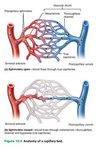(LESSON 16) Blood Vessels Flashcards
(69 cards)
Structure of Arteries, Veins, and Capillaries
Image

Lumen
the central blood-filled space of the blood vessel
Tunica Intima
innermost tunic of a vessel wall in intimate contact with the blood in the lumen.
- Internal layer of simple squamos epithelium
- Forms a smooth surface that minimizes friction of blood flow
- Subendothelial layer lies just external to endothelium
- In vessels larger than 1mm in diameter
- Loose connective tissue
Tunica Media
- Middle tunic
- consists primarily of circular smooth muscles fibers with circular sheets of elastin and collagen fibrils between
- Thicker in arteries than veins
- Maintains blood pressue
-
Vasoconstriction**
- Contraction of the smooth muscle cells with decreases the diameter of the vessel
-
Vasodilation
- Relaxation of the muscle cells that increases vessel diameter
- Both activities are regulated by vasometer nerve fibers.
Tunica Externa
- The outermost layer of the vessel wall
- a layer of connective tissue that contains many collagen and elastic fibers
- fibers run longitudinally
- protects the vessel, strengthens wall, anchors vessel to surrounding structures
Arteries
- Vessels that carry blood away from the heart.
- In systemic circuit blood is oxygen-rich
- in pulmonary circuit blood is oxygen-poor
- Blood proceeds from elastic arteries to muscular arteries, to arterioles
Elastic arteries
- the largest arteries near the heart. ie aorta and major branches
- from 2.5 cm to 1 cm in diameter
- AKA conducting arteries
- High elastin content dampens the surges of blood pressure

Muscular Arteries
- AKA distributing arteries
- Distal to elastic arteries
- supply groups of organs, individual organs, and parts of organs
- Constitute most of the named arteries
- 1cm-0.3mm in diameter
- thicker tunica media can regulate the amount of blood going to certain organs, according to needs

Arterioles
- Smallest arteries
- 0.3mm-10wm? in diameter
- contain only 1-2 layers of smooth muscle cells
- Nervous system and local factors determine diameter

Capillaries
- The smallest bust most important blood vessels
- 8-10wm in diameter
- Renew surrounding tissue fluid of all body cells with oxygen and nutirents
- remove CO2 and Nitrogenous waste
- Just large enough to allow erythrocytes to pass through in single file
- composed of one layer of endothelial cells surrounded by a basement membrane (tunica intima)
- Some capillaries perform site-specific functions
- Lungs: oxygen enters blood through capillaries
- Small intestine: receive digestive nutrients
- endocrine glands: pick up hormones
- Kidneys: remove nitrogenous waste
Capillary Bed
- A network of the body’s smallest vessels
- run through almost all tissue, especially loose connective tissue
- When precapillary sphincters relax, blood fills the true capillaries
- when sphinctes contract, they force most blood to flow straight from metarterioles to thoroughfare channels, bypassing the true capillaries

Metarteriole
A vessel that is structurally intermediate between an arteriole and a capillary-from which branch true capillaries.
Terminal arteriole-metarteriole-thoroughfare channel-postcapillary venule
Thoroughfare channel
A vessel structurally intermediate between a capillary and a venule. True capillaries merge into this, which then join the venule
Precapillary sphincters
- Smooth muscle that wraps around the root of each true capillary where it leaves the metarteriole.
- regulates bood flow to surrounding tissue according to needs for oxygen and nutrients.
Structure of Capillries Cut in Cross section
image
A. Continuous Capillary
B. Fenestrated Capillary
C. Sinusoidal Capillary

Intercellular Clefts
- Gaps of unjoined membrane
- small molecules exit and enter cavity here
Pericyte
- spider shaped cells that strengthen and stabilize capillary
- Thin processes form a network that is widely spaced to not interfere with spillary permeability
- External to endothelial cells
Continous VS Fenestrated Capillaries
Fenestrated: Have pores (fenestrations) spanning the endothelial cells. Occur only in areas of exceptionally high rates of exchange between blood and surrounding tissue fluid.
- small intestine, kidneys, synovial membrane of joints.
Continuous: No pores. More common, occuring in most organs of the body
- Skeletal muscle, skin, and central nervous system
Routes of capillary permeability
- Direct diffusion through endothelial cell membrane
- C02/Oxygen
- intercellular clefts
- most exchange of small molecues
- pinocytotic vesicles that invaginate from plasma membrane and migrate across the endothelial cell.
- transport dissolved gases, nutrients, and waste
- Fenestrations in fenestrated capillaries
Low Permeability: Blood-Brain Barrier
- Complete tight junctions
- no fenestrations or intercellular clefts
- vital molecules for the brain are ushered through endothelial cells.
- CO2, Oxygen, and some anesthetics may also diffuse unhindered
- Prolonged emotional stress can cause tight junctions in brain to open, allowing toxic substances through
- Gulf War Syndrome
Sinusoids
or
Sinusoidal Capillaries
- Wide, leaky capillaries
- Twisted course and large diameter ensure that blood slows to allow time for many exchanges to occur
- Occur with extensive exchange of large materials
- proteins
- cells
- Occur in
- Bone Marrow
- spleen
- Usually fenestrated
- fewer cell junctions
- in some, intercellular clefts are wide open
Veins
- The blood vessels that conduct blood from capillaries toward the heart.
- Systemic circuit: carry oxygen-poor blood
- Pulmonary circuit: carry oxygen rich blood returning from lungs
- Blood pressure much lower than in arteries
- blood pressure declines substantially passing through arterioles/cap. beds
- Walls of veins are much thinner
- At any time veins hold 65% of body’s blood
Venules
- The smallest veins
- 8-100wm in diameter
- Join to form veins
Postcapillary venules
- The smallest venules
- consist of endothelium on which lie pericytes
- Function like capillaries
- during inflammatory responses more fluid and leukocytes leave the circulation through these than through capillaries
*









